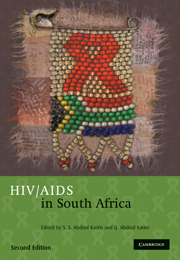Book contents
- Frontmatter
- Contents
- List of Contributors
- Foreword: Peter Piot
- Foreword: Nelson R Mandela
- Acknowledgements
- Section 1 Birth of a rapidly growing epidemic
- Section 2 The virus, the human host and their interactions
- 5 Viral structure, replication, tropism, pathogenesis and natural history
- 6 HIV diagnostics
- 7 HIV-1 genetic diversity
- 8 Cellular immunity in HIV: a synthesis of responses to preserve self
- Section 3 HIV risk factors and prevention strategiess
- Section 4 Focal groups for understanding the HIV epidemic
- Section 5 The impact of AIDS
- Section 6 Treating HIV
- Section 7 What does the future hold?
- Index
7 - HIV-1 genetic diversity
Published online by Cambridge University Press: 07 September 2011
- Frontmatter
- Contents
- List of Contributors
- Foreword: Peter Piot
- Foreword: Nelson R Mandela
- Acknowledgements
- Section 1 Birth of a rapidly growing epidemic
- Section 2 The virus, the human host and their interactions
- 5 Viral structure, replication, tropism, pathogenesis and natural history
- 6 HIV diagnostics
- 7 HIV-1 genetic diversity
- 8 Cellular immunity in HIV: a synthesis of responses to preserve self
- Section 3 HIV risk factors and prevention strategiess
- Section 4 Focal groups for understanding the HIV epidemic
- Section 5 The impact of AIDS
- Section 6 Treating HIV
- Section 7 What does the future hold?
- Index
Summary
HIV IS A MEMBER of a group of viruses referred to as the primate-infecting lentiviruses of the family Retroviridae. There are two HIV types: HIV-1 (including three lineages called the M, N and O groups) and HIV-2 (including three lineages called the A, B, and G groups). Viruses within the HIV-1 M group are primarily responsible for the global AIDS epidemic. The epidemic probably began when an ancestral HIV-1 M virus was transmitted to humans from chimpanzees in equatorial West Africa at some time around the 1930s. The HIV-1 M genetic diversity that has subsequently arisen has required subdivision of the group into nine subtypes (called A, B, C, D, F, G, H, J, and K). Subtype C viruses overwhelmingly dominate the South African epidemic. Evidence suggests that multiple subtype C incursions into South Africa have occurred from elsewhere in Africa.
Extreme genetic diversity, a consequence of the error-prone and recombinogenic nature of hiv replication, seriously threatens our chances of containing the aids epidemic. Viruses within an infected person can rapidly evolve to evade immune responses (both natural and vaccine induced) and antiretroviral drugs. Despite the South African epidemic being characterised by lower hiv diversity than elsewhere in Africa, effective control of hiv using vaccines and drug therapy here may be compromised by the massive evolutionary potential of this virus.
HIV classification and diversity
hiv belongs to the family Retroviridae and the genus Lentivirus: Lenti meaning slow and reflecting the long time it takes from infection to disease.
- Type
- Chapter
- Information
- HIV/AIDS in South Africa , pp. 117 - 126Publisher: Cambridge University PressPrint publication year: 2010

